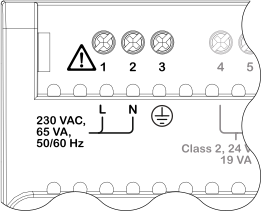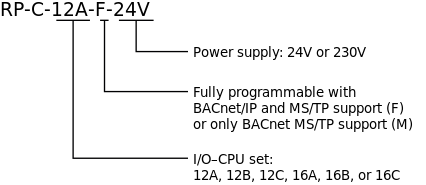The RP-C can be installed on a DIN rail or other flat surface inside a cabinet. In general, the device is recommended to be installed in a cabinet, unless local regulations allow an exception.
Rules and regulations
RP-C models with built-in wireless chip must be professionally installed to comply with the following rules and regulations:
Part 15 of the Federal Communications Commission (FCC) rules
Innovation, Science and Economic Development Canada (ISED) licence-exempt Radio Standards Specifications (RSSs)
2014/53/EU Radio Equipment Directive (RED) of the European Union (EU)
S.I. 2017/1206 - Radio Equipment Regulations 2017 of the United Kingdom (UK)
For more information, see RP-C Regulatory Compliance and Approvals
.
The RP-C and its antenna(s) must be installed to provide a separation distance of at least 20 cm (8 in.) from all persons and must not be co-located or operating in conjunction with any other antenna or transmitter. Information on recommended RF exposure limits can be obtained from Health Canada's website,
www.canada.ca/en/health-canada
.
Installation orientation restrictions
The restrictions on installing the device in various orientations differ between the different RP-C controller models (
For more information, see RP-C Models
.). In this regard, the RP-C models can be divided in the following categories:
RP-C 24 V models with “-F” in the product name:
RP-C-12A-F-24V, RP-C-12B-F-24V, RP-C-12C-F-24V, and RP-C-16B-F-24V
RP-C 24 V models with “-M” in the product name:
RP-C-12A-M-24V, RP-C-12B-M-24V, and RP-C-16A-M-24V
RP-C 230 V models: RP-C-16A-F-230V and RP-C-16B-F-230V
RP-C 230 V model: RP-C-16C-F-230V
|
Notice
|
|
CONTROLLER DAMAGE
Follow the installation orientation restrictions that apply to the specific RP-C controller model.
Failure to follow these instructions can result in equipment damage.
|
RP-C-12A-F-24V, RP-C-12B-F-24V, RP-C-12C-F-24V, and RP-C-16B-F-24V
Under normal operating conditions of 0 to 50 °C (32 to 122 °F), the RP-C 24 V controller models RP-C-12A-F-24V, RP-C-12B-F-24V, RP-C-12C-F-24V, and RP-C-16B-F-24V can be installed in the following orientations:
Horizontally (on a DIN rail going from left to right), with the device label text in the upright position reading left to right. See “a” in the following figure.
Vertically (on a DIN rail going from top to bottom), which means that the device is rotated +90 degrees or -90 degrees from the horizontal position. See “b” and “c” in the following figure.
Face down from a ceiling. See “d” in the following figure.
Face up on a horizontal surface. See “f” in the following figure.
The only installation orientation that is not supported for the RP-C 24 V controller models is when the device is rotated 180 degrees from the horizontal position, that is, with device label text up and down. See “e” in the following figure. In the up and down position, the controller's thermal specifications may be exceeded, which can damage the controller.
action_zoom_plus_stroke

Figure:
Installation orientation restrictions for the RP-C 24 V controller models operated in normal conditions, 0 to 50 °C (32 to 122 °F)
When the RP-C 24 V controller models are used for rooftop applications, -40 to +60 °C (-40 to +140 °F), the device should be installed horizontally, with the device label text in the upright position reading left to right. See “a” in the following figure. Any other installation orientation (“b”, “c”, “d”, “e”, and “f” in the figure) may exceed the controller's thermal specifications, which can damage the controller.
action_zoom_plus_stroke

Figure:
Installation orientation restrictions for the RP-C 24 V controller models operated at -40 to +60 °C (-40 to +140 °F)
RP-C-12A-M-24V, RP-C-12B-M-24V, and RP-C-16A-M-24V
Under normal operating conditions of 0 to 50 °C (32 to 122 °F), the RP-C 24 V controller models RP-C-12A-M-24V, RP-C-12B-M-24V, and RP-C-16A-M-24V can be installed in the following orientations:
Horizontally (on a DIN rail going from left to right), with the device label text in the upright position reading left to right. See “a” in the following figure.
Vertically (on a DIN rail going from top to bottom), which means that the device is rotated +90 degrees or -90 degrees from the horizontal position. See “b” and “c” in the following figure.
Face down from a ceiling. See “d” in the following figure.
Up and down, which means that the device is rotated 180 degrees from the horizontal position and with the device label text up and down. See “e” in the following figure.
Face up on a horizontal surface. See “f” in the following figure.
action_zoom_plus_stroke

Figure:
Installation orientations for the RP-C 24 V controller models operated in normal conditions, 0 to 50 °C (32 to 122 °F)
RP-C-16A-F-230V and RP-C-16B-F-230V
Under normal operating conditions of 0 to 50 °C (32 to 122 °F), the RP-C 230 V controller models RP-C-16A-F-230V and RP-C-16B-F-230V can be installed in the following orientations:
Horizontally (on a DIN rail going from left to right), with the device label text in the upright position reading left to right. See “a” in the following figure.
Vertically (on a DIN rail going from top to bottom), which means that the device is rotated +90 degrees or -90 degrees from the horizontal position. See “b” and “c” in the following figure.
Installing the RP-C 230 V controller models rotated 180 degrees from the horizontal position is not supported. See “e” in the following figure. Installing the RP-C 230 V controller models face down from a ceiling (“d” in the figure) or face up on a horizontal surface (“f” in the figure) is only supported in the operating temperature range 0 to 40 °C (32 to 104 °F), but not in the temperature range 0 to 50 °C (32 to 122 °F). Installing the controller in an orientation that is not supported may cause the controller's thermal specifications to be exceeded, which can damage the controller.
action_zoom_plus_stroke

Figure:
Installation orientation restrictions for the RP-C 230 V controller models operated in normal conditions, 0 to 50 °C (32 to 122 °F)
RP-C-16C-F-230V
Under normal operating conditions of 0 to 50 °C (32 to 122 °F), the RP-C 230 V controller model RP-C-16C-F-230V can be installed in the following orientations:
Horizontally (on a DIN rail going from left to right), with the device label text in the upright position reading left to right. See “a” in the following figure.
Vertically (on a DIN rail going from top to bottom), which means that the device is rotated +90 degrees or -90 degrees from the horizontal position. See “b” and “c” in the following figure.
Face down from a ceiling. See “d” in the following figure.
Up and down, which means that the device is rotated 180 degrees from the horizontal position and with the device label text up and down. See “e” in the following figure.
Face up on a horizontal surface. See “f” in the following figure.
action_zoom_plus_stroke

Figure:
Installation orientations for the RP-C-16C-F-230V controller model operated in normal conditions, 0 to 50 °C (32 to 122 °F)
Installation on a DIN rail
A DIN rail is a common and convenient technique for installing the RP-C controller along with other associated control and monitoring devices. The most efficient ventilation is achieved with the wall-mounted DIN rail oriented horizontally and with adequate space provided between the RP-C rail and adjacent rails or other devices.
The RP-C controller is typically installed horizontally (on a DIN rail going from left to right), with the device label text in the upright position reading left to right.
action_zoom_plus_stroke

Figure:
Example of an RP-C controller installed on a horizontal DIN rail
DIN rail end clip
To help prevent the device from sliding down or sideways on the DIN rail, install an end clip for DIN 35 (part number SXWDINEND10001) tightly against the bottom or rightmost device on the rail. The end clip is easily removed if you bend the snap lock open with a screwdriver.
|
Notice
|
|
EQUIPMENT DAMAGE
Use an end clip (part number SXWDINEND10001) when you install the device on a vertical DIN rail.
Failure to follow these instructions can result in equipment damage.
|
action_zoom_plus_stroke

Figure:
End clip for DIN 35 fixed across the DIN rail
Installation in a cabinet
All RP-C controller models, except RP-C-16C-F-230V, are recommended to be installed in a cabinet, unless local regulations allow an exception.
Important:
The device should be installed within an enclosure such as a control cabinet for isolation to exposed live parts.
action_zoom_plus_stroke

Figure:
RP-C controllers installed on horizontal DIN rails in a cabinet
When installing RP-C controllers in a cabinet, it is recommended to provide ample space between the DIN rails and controllers for sufficient ventilation.
Screw terminals or connectors
All RP-C controller models, except RP-C-16C-F-230V, have fixed screw terminals.
For more information, see RP-C Screw Terminals
.
The RP-C-16C-F-230V controller model has PCB mounted connectors.
For more information, see RP-C-16C-F-230V Pluggable Connectors
.
Anchor points for cable ties
All RP-C controller models, except RP-C-16C-F-230V, have four anchor points that can be used to fasten cable ties or other accessories for bundling wires.
action_zoom_plus_stroke

Figure:
Anchor points for cable ties
Optional covers
All RP-C controller models, except RP-C-16C-F-230V, can be equipped with optional covers to reduce access to the screw terminals and wires if desired. Covers are not available for RP-C-16C-F-230V as its design with pluggable connectors instead of screw terminals reduces access to the wiring.
action_zoom_plus_stroke

Figure:
Optional covers


 Tip:
Tip: RP-C Device Installation
RP-C Device Installation
 RP-C Models
RP-C Models
 RP-C Screw Terminals
RP-C Screw Terminals
 RP-C-16A-F-230V Screw Terminals
RP-C-16A-F-230V Screw Terminals
 RP-C-16B-F-230V Screw Terminals
RP-C-16B-F-230V Screw Terminals
 Powering Up an RP-C-16C-F-230V Controller Model
Powering Up an RP-C-16C-F-230V Controller Model
 Differences Between RP-C Hardware Versions
Differences Between RP-C Hardware Versions
 RP-C LED
RP-C LED
 Status LEDs
Status LEDs










